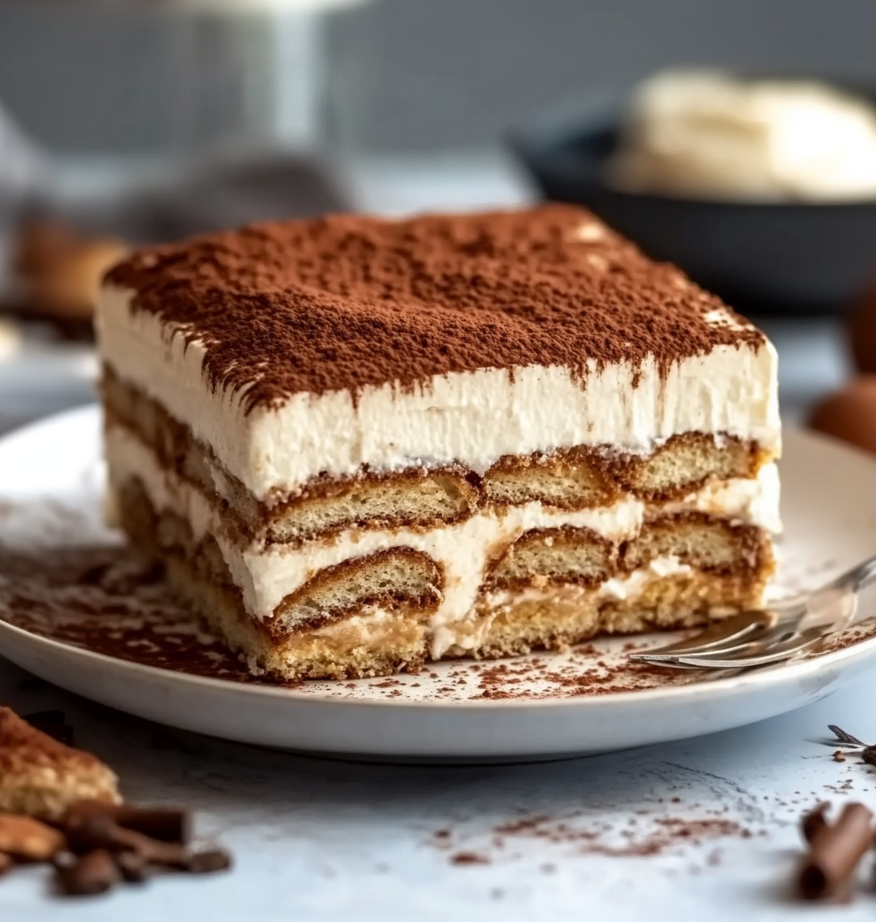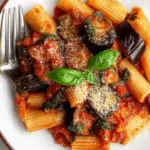Indulge in the classic Italian dessert with this Easy Tiramisu recipe. Featuring layers of coffee-soaked ladyfingers and a creamy mascarpone filling, it’s a delightful treat that’s simple to prepare.
Full Recipe:
Ingredients
- 6 egg yolks
- 3/4 cup granulated sugar
- 2/3 cup milk
- 1 1/4 cups heavy cream
- 8 oz mascarpone cheese
- 1/2 cup strong brewed coffee, cooled
- 2 tbsp coffee liqueur (optional)
- 24 ladyfinger cookies
- Unsweetened cocoa powder, for dusting
Directions
- In a medium saucepan, whisk together egg yolks and sugar until well blended.
- Whisk in milk and cook over medium heat, stirring constantly, until the mixture boils.
- Boil gently for 1 minute, remove from heat, and allow to cool slightly.
- Cover tightly and chill in the refrigerator for 1 hour.
- In a medium bowl, beat heavy cream with an electric mixer until stiff peaks form.
- Whisk mascarpone into the yolk mixture until smooth.
- In a small bowl, combine coffee and coffee liqueur.
- Dip each ladyfinger into the coffee mixture for about 1 second and arrange in the bottom of a 7×11 inch dish.
- Spread half of the mascarpone mixture over the ladyfingers, then half of the whipped cream over that.
- Repeat layers and sprinkle with cocoa powder.
- Cover and refrigerate for at least 4 hours before serving.
Nutrients
Per serving (based on 12 servings):
- Calories: 310
- Total Fat: 20g
- Saturated Fat: 12g
- Cholesterol: 140mg
- Sodium: 45mg
- Total Carbohydrates: 25g
- Sugars: 15g
- Protein: 5g
Why Tiramisu is a Timeless Dessert
Tiramisu’s appeal lies in its perfect balance of flavors and textures. The boldness of espresso-soaked ladyfingers contrasts beautifully with the silky, mildly sweet mascarpone cream. The final dusting of cocoa powder adds a slight bitterness that cuts through the richness, creating a harmonious taste experience.
Unlike many baked desserts, tiramisu requires no oven, making it accessible and easy to prepare at home. This no-bake quality also contributes to its soft, melt-in-your-mouth texture, distinguishing it from heavier cream or custard-based desserts. The combination of chilled creaminess and the aroma of coffee makes it an ideal dessert for any season, whether as a refreshing summer treat or a comforting winter indulgence.
The Cultural Significance of Tiramisu
In Italy, tiramisu is more than just a dessert; it’s a culinary icon that reflects Italian craftsmanship and love for simple yet elegant food. It often graces the tables during family gatherings, festive occasions, and celebrations, symbolizing warmth and togetherness. The recipe itself showcases traditional Italian ingredients—espresso, mascarpone, eggs, and cocoa—highlighting the country’s rich agricultural heritage.
Outside Italy, tiramisu has become a global ambassador of Italian cuisine. It features prominently in Italian restaurants around the world and inspires chefs to innovate by incorporating local flavors and ingredients. Whether served in a traditional form or reimagined with twists like fruit infusions or different liqueurs, tiramisu remains a favorite among food enthusiasts.
Key Ingredients That Make Tiramisu Special
Although this section will not include the exact breakdown, it’s important to understand why each ingredient is vital to the recipe’s success. Mascarpone cheese, a creamy Italian cheese, provides the smooth and luxurious texture that defines tiramisu’s filling. The eggs add richness and help create a custard-like consistency when combined with sugar and milk.
Coffee is the heart of tiramisu. Strong, freshly brewed espresso is ideal because its intense flavor soaks into the ladyfingers, imparting a deep coffee taste that balances the sweetness of the cream. The coffee liqueur, often optional, adds an extra layer of complexity and warmth to the dish.
Ladyfinger cookies, or savoiardi, are light and airy biscuits that absorb the coffee without becoming soggy too quickly. Their delicate texture contrasts with the creamy layers, contributing to tiramisu’s signature mouthfeel. The final touch of cocoa powder not only enhances flavor but also adds visual appeal with its dark dusting.
Tips for Making the Perfect Tiramisu
Achieving the perfect tiramisu involves attention to a few key details. First, the coffee must be strong and fully cooled before dipping the ladyfingers. Warm coffee can make the cookies soggy and ruin the texture of the dessert.
When beating the cream and incorporating mascarpone, it’s important to avoid overmixing to keep the cream light and fluffy. Similarly, carefully folding the ingredients helps maintain the airy texture of the filling.
The layering process should be done gently to preserve the structure of the ladyfingers and cream. After assembling, chilling the tiramisu for several hours or overnight allows the flavors to meld beautifully and the dessert to firm up for easier slicing and serving.
Variations of Tiramisu Around the World
While the classic tiramisu remains a favorite, many variations have emerged worldwide. Some recipes incorporate fruits such as strawberries or raspberries for a refreshing twist. Others substitute coffee with other flavored syrups or liquors like amaretto, Bailey’s, or rum.
There are also vegan and dairy-free versions using alternatives like coconut cream and plant-based mascarpone. For those avoiding raw eggs, some recipes replace the traditional custard with stabilized whipped cream or use pasteurized eggs for safety.
Each variation brings a unique spin on the original, demonstrating tiramisu’s versatility and universal appeal.
Serving Suggestions and Pairings
Tiramisu is best served chilled and can be presented in individual glasses or a large dish for sharing. It pairs wonderfully with espresso or a dessert wine like Marsala, complementing the rich flavors.
For a special occasion, garnish tiramisu with chocolate shavings, fresh berries, or a sprinkle of cinnamon to add extra aroma and texture. It can also be accompanied by fresh fruit or a scoop of vanilla ice cream for an elevated dessert experience.
Health Considerations
While tiramisu is undeniably delicious, it is also rich in calories, fats, and sugars. It is best enjoyed in moderation as a treat rather than a regular part of the diet. For those with dietary restrictions, options exist to adapt the recipe, such as using sugar substitutes or lighter creams.
Conclusion
Tiramisu remains a timeless and iconic dessert that captivates taste buds with its harmonious blend of coffee, cream, and cocoa. Its relatively simple preparation combined with luxurious flavors makes it a favorite both in Italy and around the globe. Whether enjoyed as a comforting homemade treat or a refined restaurant dessert, tiramisu continues to uplift and delight.






